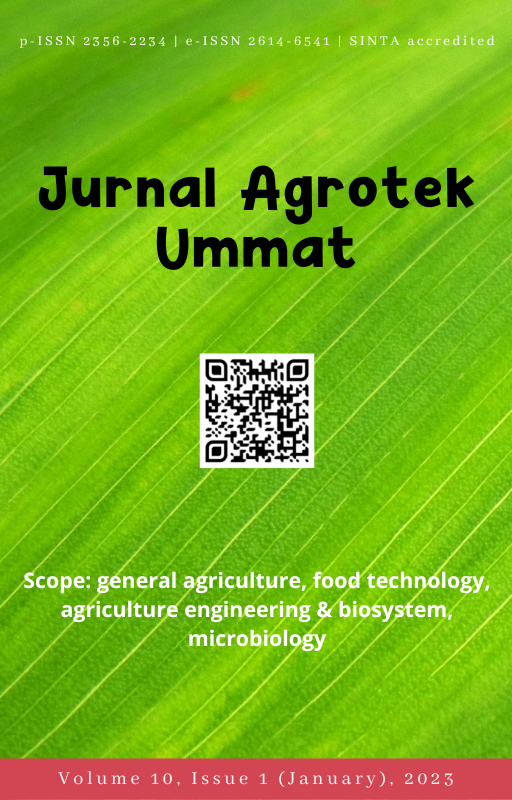Characteristics of drying banana kepok based on the thickness of the slices and the alternating process in making banana sale
DOI:
https://doi.org/10.31764/jau.v10i1.12860Keywords:
banana kepok, drying, thick slicesAbstract
One of processed bananas that has a long shelf life is banana fritter. Banana fritter is made by slicing bananas in various thicknesses and then drying them. Drying intends to reduce or eliminate the water content in bananas. This study aims to determine the drying characteristics of kepok bananas based on the thickness of the slices and the back and forth process in making banana fritter. The design used in this study was a completely randomized design (CRD) with two types of thickness, namely 1 cm (K1) and 1.5 cm (K2) cm and there were once (B1) and twice (B2) alternating process treatments respectively in a day. Research data were analyzed using SPSS. The results showed that the degree of thickness (K) significantly affected the mass change of bananas during drying (P value = 0.0001), and the alternating process of bananas (B) did not affect the mass change of bananas during drying (P value = 0.532), while the combination between treatment B and K did not have a significant effect (P value = 0.385). From the results of this study it can be concluded that the thickness of the dried kepok banana slices greatly affects the characteristics of the resulting banana fritter. The drying rate and MR value are directly proportional to the amount of moisture in the banana during drying which is shown at a thickness level of 1.5 cm, so it is advisable to carry out further research mechanically with a thickness level of 1.5 cm kepok banana slices.
References
Aprilandani, S., & Tanggasari, D. (2022). LAMA WAKTU PENYIMPANAN THE EFFECT OF TEMPERATURE AND HUMIDITY ON BANANA SALE PRODUCTS IN VARIATION OF PACKAGING. Protech Biosystem Journal, 2(2), 91-97.
Arsyad dan Supu. (2022). Pengaruh Lama Pengeringan terhadap Karakteristik Fisikokimia Pisang Sale. Perbal: Jurnal Pertanian Berkelanjutan, 10(1), 53–62. https://doi.org/10.30605/perbal.v10i1.1540
Desmawan, D., Syaifudin, R., & Setyadi, S. (2022). Optimization BUMDes through Processing Of Banana Agricultural Products Into Banana Sale, To Obtain Added Value in Cihanjuang Village, Cibaliung. MOVE: Journal of Community Service and Engagement, 2(1), 1–4. https://doi.org/10.54408/move.v2i1.121
Falade, K. O., & Oyeyinka, S. A. (2015). Color, Chemical and Functional Properties of Plantain Cultivars and Cooking Banana Flour as Affected by Drying Method and Maturity. Journal of Food Processing and Preservation, 39(6), 816–828. https://doi.org/10.1111/jfpp.12292
Fithriani, D., Assadad, L., & Siregar, A. (2016). KARAKTERISTIK DAN MODEL MATEMATIKA KURVA PENGERINGAN RUMPUT LAUT Eucheuma cottonii Characteristics and Mathematical Model of Drying Curve of Eucheuma cottonii Seaweed. 159–170.
Hasanah, U., Masyhuri, M., & Djuwari, D. (2016). Analisis Nilai Tambah Agroindustri Sale Pisang di Kabupaten Kebumen. Ilmu Pertanian (Agricultural Science), 18(3), 141. https://doi.org/10.22146/ipas.10615
Histifarina, Rachman, A., Rahadian, D., & Sukmaya. (2012). Teknologi Pengolahan Tepung Dari Berbagai Jenis Pisang Menggunakan Cara Pengeringan Matahari Dan Mesin Pengering. Agrin, 16(2), 125–133.
Nurmuliana, E., Jamaluddin, J., & Mustarin, A. (2022). Model Matematika Lapisan Tipis Pengeringan Buah Mahkota Dewa (Phaleria macrocarpa). Jurnal Pendidikan Teknologi Pertanian, 8(1), 57. https://doi.org/10.26858/jptp.v8i1.21675
Nursyafitri, I., & Tanggasari, D. (2022). PENGARUH PENGERINGAN MENGGUNAKAN OVEN TERHADAP SUHU , KELEMBABAN , KADAR AIR PRODUK. Protech Biosystem Journal, 2(2), 57–64.
Putri, T. K., Veronika, D., Ismail, A., Karuniawan, A., Maxiselly, Y., Irwan, A. W., & Sutari, W. (2015). Pemanfaatan jenis-jenis pisang (banana dan plantain) lokal Jawa Barat berbasis produk sale dan tepung. Kultivasi, 14(2), 63–70. https://doi.org/10.24198/kultivasi.v14i2.12074
Rahman, ANF. Mahendradatta, M. E. et al. (2018). Vol. 1 Issue 2, 20 Desember 2018. 1(2), 118–126.
Rofikah, W. P. dan W. S. (2014). PEMANFAATAN PEKTIN KULIT PISANG KEPOK (Musa paradisiaca Linn) UNTUK PEMBUATAN EDIBLE FILM. Indonesian Journal of Chemical Science, 3(2252).
Santoso, D., Muhidong, D., & Mursalim, M. (2018). MODEL MATEMATIS PENGERINGAN LAPISAN TIPIS BIJI KOPI ARABIKA (Coffeae arabica) DAN BIJI KOPI ROBUSTA (Coffeae cannephora). Jurnal Teknologi Pertanian Andalas, 22(1), 86. https://doi.org/10.25077/jtpa.22.1.86-95.2018
Tanggasari, D., Nelwan, L. O., & Yulianto, M. (2023). Pengaruh Tinggi Tumpukan dan Proses Tempering Terhadap Mutu Gabah yang Dikeringkan dengan Fluidized Bed Dryer. Warta Industri Hasil Pertanian, 39(2),95-103.
Yang, L., Hu, Z., Yang, L., Xie, S., & Yang, M. (2018). Hot-air drying characteristics and quality evaluation of bitter melon slice. INMATEH - Agricultural Engineering, 55(2), 53–62.
Downloads
Published
Issue
Section
License
Authors who publish articles in Jurnal Agrotek Ummatagree to the following terms:- Authors retain copyright of the article and grant the journal right of first publication with the work simultaneously licensed under a CC-BY-SA or The Creative Commons Attribution–ShareAlike License.
- Authors are able to enter into separate, additional contractual arrangements for the non-exclusive distribution of the journal's published version of the work (e.g., post it to an institutional repository or publish it in a book), with an acknowledgment of its initial publication in this journal.
- Authors are permitted and encouraged to post their work online (e.g., in institutional repositories or on their website) prior to and during the submission process, as it can lead to productive exchanges, as well as earlier and greater citation of published work (See The Effect of Open Access).

